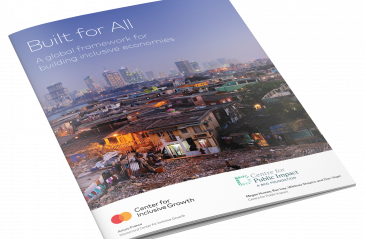
Systemic funding architecture: A proposition to catalyze urban climate finance

Impact investing can help fill Australia's financial void
Share articleAustralia is punching above its weight on the global stage of impact investing
Share articleImpact investing can’t solve everything but it can make a good contribution
Share articleWe put our vision for government into practice through learning partner projects that align with our values and help reimagine government so that it works for everyone.
Daniel Madhavan is in no doubt. “It is pretty evident that government - both in Australia and overseas - does not have the money to fund all of the things that we, as citizens would like to see,” he says.
But there's no reason to despair, he is quick to add. “Although philanthropy has an incredibly important role to play, it can't bridge the entire gap because it's simply too big. So this is where impact investing can help fill the void - and it's in the process of taking off.”
Impact investing - a field of investment that intentionally creates positive social or environmental impact as well as a financial return - is no overnight phenomenon. Its value lies in its ability to bring additional resources and new funding models to the process of addressing entrenched social challenges which governments or third sector organisations have been struggling with.
In his role as chief executive of Impact Investing Australia - an organisation “set up in 2014 in response to an industry-identified need for dedicated leadership, facilitation and capacity building” - Madhavan is leading the charge. And his sense of excitement is palpable.
“My read on the market is that over the past 12 months, we have moved from the innovators' phase to early-adopters,” he says. “There have been some amazing people doing great work for over a decade in this space but, anecdotally at least, we have seen a tipping point over the last year or so, where larger and more mainstream organisations are starting to participate.”
Asked what is driving this and Madhavan says it is all about outcomes and the need to step in where government is unable to venture. “Australia is far from alone in facing a growing divide between the demand for social services and what government can afford,” he points out. “There is now a real hunger out there for new solutions and for new financial models that can be scaled up. Taking the UK as an example, it is probably more driven by social services and a very supportive framework of government policy. The US, by contrast, is more reliant on the foundations and philanthropic community. In Australia, it's probably a mix of both.”
He goes on to say that there are three main areas of focus for his organisation. Although they have proven very popular in the UK, for example, social impact bonds are yet to fully take off in Australia in terms of completed transactions. “We have a federated system and it is being very much being driven by the states, with New South Wales leading the way,” he explains.
“And if you look at social enterprise this is probably being driven on one side by non-profit organisations looking to create more enterprise-driven models that have more sustainable revenue streams,” he continues. “On the other side you've got a generation of young social entrepreneurs who are really looking to embed social change in the business models they are creating.”
The third aspect, he explains, concerns real assets such as housing and clean energy - anything that involves some investment in an asset. “I think this is driven more by need than anything else,” he observes. “Housing is a really great example of something where there is real demand for social and affordable housing; housing for people with disabilities; and so on. I don't think we've really nailed these models yet but there is definitely the demand there and there is a lot of activity to try and figure out how to create investable models.”
Impact investing is further ahead in the UK and the US but Australia is already punching above its weight on the global stage. This is because the Australian context is well suited to reap the benefits that impact investment can provide. For example, it can help lead to economic participation and independence for Indigenous Australians.
And looking more broadly, Madhavan says that there are a whole range of social programmes which would lead to a positive impact for an array of stakeholders. “These include cost savings to the taxpayer, increased funding for mission-focused organisations and the positive outcomes that we're all seeking on behalf of the beneficiary groups,” he says.
Social enterprise, too, stands to help Australians in clear and demonstrable ways, he adds. “One is technology and the use of technology - like in disability services, for example. Its funding model has shifted to a market-based system so it has been undergoing huge disruption. People with disabilities now get a lot more choice about how to spend the funding, and technology is playing a huge part in that.”
The other area is employment. “We are seeing a lot of enterprises where they can support groups towards more long-term employment,” he explains. “This might be for people coming out of prison or the long-term unemployed or have specific challenges attaining mainstream long-term employment and they're using social enterprise as a bridge to get there.”
Such benefits are easily understood and not beholden to either end of the political spectrum - who can argue against tailored support for people with disabilities, for example. But Madhavan adds that while the benefits unite politicians, impact investing remains a subject of debate in some quarters. “Where it is challenging is that everyone is trying to anticipate what the costs might be,” he points out. “This is because any change typically has some cost attached to it and this is likely to catch the eye of some in the political arena.”
Overcoming any opposition, however, is partly what Impact Investing Australia has been set up to do. Madhavan pinpoints three main priorities. “One is as a convenor - connecting at an industry level the key players and different groups of stakeholders such as government, the community sector and investors,” he says.
“We also do a lot of work around policy - trying to influence policy at state and federal government level about what can be done to create a more supportive environment for impact investment. And we work on the sort of infrastructure that a market in its infancy needs to keep developing. For example, we've done a lot of work on collecting data around the levels of demand that is there for these investments, the type of impact and financial performance that have been achieved, as well as scoping the size of the market as a whole.”
Madhavan and his team are also working with Big Society Capital in the UK to look at and design what an institution like that could look like for Australia.”We co-designed Impact Capital Australia with a cross-sector group of 15 senior leaders and support from Big Society Capital, Ashurst and ATKearney,” he says. “The blueprint was launched in October last year outlining the case for why it is needed and the role it could play in the Australian impact investment landscape.”
These activities will underpin the future direction of travel for impact investing in Australia - a future which Madhavan believes is laced with huge potential. “This can't solve everything - and it's not meant to - but it can make a good contribution. We've got an environment that is very supportive of impact investment as a concept. It's now down to us to find out how we can deploy it efficiently at scale and ensure that we don't lose the central premise that this money should go towards the social and environmental outcomes that we all want to see. As motivational goals go, I can't think of many better!”











